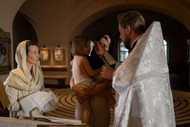The Value of Clergy Vestments During Worship
Sep 25th 2023
Clergy vestments play a pivotal role in the spiritual and visual aspects of worship within various religious traditions. These distinctive garments worn by clergy members hold deep symbolic meaning, enhance the reverence of the worship experience, and contribute to a sense of unity among congregants.
But what is the significance and value of clergy vestments during worship? What does it symbolize for the clergy and their congregation?
Symbolism and Spirituality of Clergy Vestments
Clergy vestments are not mere garments; they are imbued with deep symbolism and spiritual significance. Each element of a vestment, from its color to its design, carries a unique meaning that reflects the clergy's role, the teachings of their faith, and their connection to the divine.
Enhancing the Worship Experience
Clergy vestments, such as COGIC bishop vestments, contribute to the multisensory experience of worship. As clergy members lead the congregation in prayer, preaching, and sacraments, their attire visually reinforces the sacred nature of these rituals. The distinctiveness of the vestments sets the clergy apart and underscores their role as mediators between the divine and the congregation.
Clergy vestments hold profound spiritual value for the people of a church, serving as tangible symbols that connect them to their faith and heritage. These sacred garments go beyond mere aesthetics, conveying deeper spiritual truths and fostering a sense of reverence within the congregation.
When clergy members don COGIC bishop vestments they become vessels through which divine teachings are imparted, reminding worshippers of their spiritual journey and the presence of the divine in their midst. The sight of clergy adorned in vestments invokes a sense of awe, humility, and respect, encouraging congregants to approach worship with open hearts and minds.
Vestments also unite the community by visually representing their shared beliefs and commitment to spiritual growth. In essence, these garments serve as a bridge between the earthly and the divine, encapsulating the essence of worship, humility, tradition, and the eternal values that form the cornerstone of the church community's faith.
Fostering a Sense of Reverence and Holiness
The presence of clergy vestments elevates the atmosphere of worship, fostering an environment of reverence and holiness. The elaborate and dignified appearance of clergy members in their vestments encourages congregants to approach worship with awe and humility.
Reflecting the Liturgical Seasons
Clergy vestments often change with the liturgical calendar, reflecting the different seasons of the church year. The colors and designs of the vestments correspond to the themes and significance of each season, guiding congregants through the rhythms of the faith.
Unifying the Congregation
The uniformity of clergy vestments serves to unite the congregation. When clergy members wear the same attire, it emphasizes their shared commitment to faith and community. This visual unity reinforces the idea that worship is a collective experience and underscores the idea of a spiritual family.
Clergy COGIC bishop vestments play a unifying role by symbolizing shared beliefs and values within a congregation. When clergy members don vestments, they visually represent the spiritual leadership and the sacredness of worship.
The consistent attire creates a sense of equality among the clergy, fostering a feeling of community. Congregants recognize these vestments as markers of authority and devotion, guiding them in their reverence and participation.
This shared visual language promotes a collective experience, reinforcing the congregation's sense of belonging, devotion, and connection to their faith and community.
Conveying Humility and Servanthood
While clergy vestments exude grandeur, they also convey humility and servanthood. The act of donning these garments reminds clergy members of their roles as servants of their faith and their congregations. The vestments serve as a visual reminder that they are vessels for carrying out the teachings of compassion, love, and service.
Respect for Tradition and Ritual
Clergy vestments honor the traditions and rituals of the faith. The attire connects contemporary worshipers with the practices of those who have come before them, creating a sense of continuity and heritage that spans generations.
These symbolic garments have deep historical roots, connecting the present with centuries-old rituals. Each vestment carries meaning and significance, reflecting the sacred roles clergy members fulfill.
Clergy show respect for the rituals, teachings, and values passed down through generations when they wear them. Vestments visually link contemporary worship with the enduring traditions of their faith, reinforcing a sense of continuity and spiritual legacy.
This display of respect for tradition through vestments upholds the sanctity of rituals and reinforces the timeless importance of religious practices.
Modern Interpretations and Adaptations
In today's diverse and evolving religious landscape, there is room for modern interpretations and adaptations of clergy vestments. While tradition is honored, some clergy members choose vestments that reflect their own cultural backgrounds or contemporary sensibilities. This blend of tradition and innovation can speak to a broader range of congregants.
Clergy vestments hold profound value during worship by channeling spirituality, enhancing reverence, and fostering unity. As clergy members don these symbolic garments, they invite congregants into a sacred space where tradition, faith, and community intersect.
Wearing vestments, combined with their spiritual significance, enriches the worship experience and deepens the connection between clergy, congregation, and the divine.
